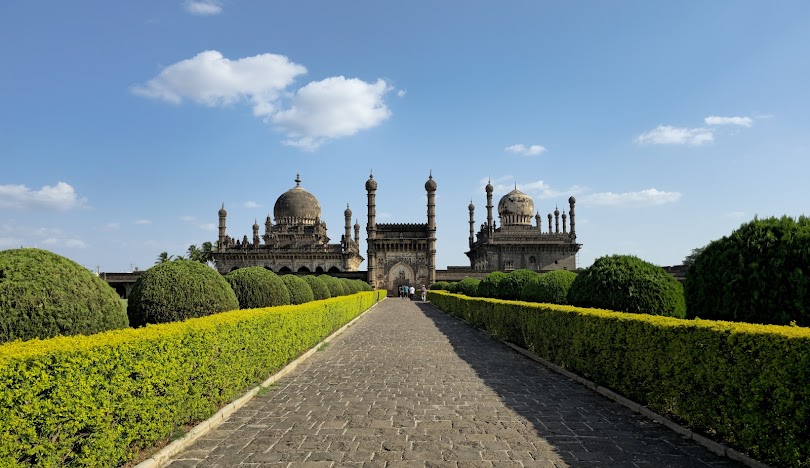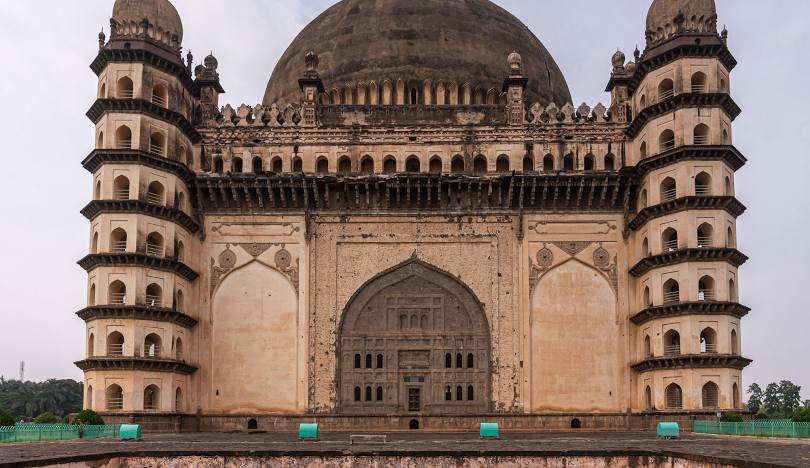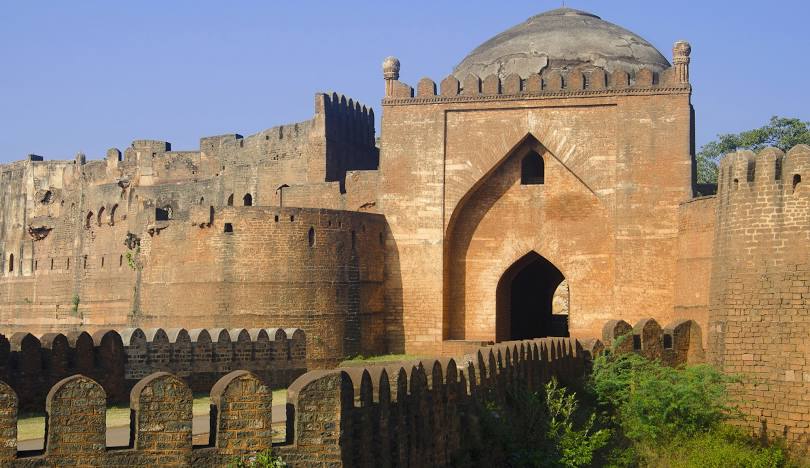
The image shows Bidar Fort, located in Bidar, Karnataka, India. The fort’s history spans over 500 years, with its origins traced back to the Western Chalukya Dynasty. It later came under the rule of the Tughlaq dynasty in 1322. In 1430, Sultan Ahmed Shah Wali of the Bahmani Dynasty made Bidar his capital and rebuilt the fort into the impressive structure seen today The region’s history includes the rule of the Kadambas (325-545 AD) and the Chalukyas of Badami (500-757 AD). Bidar became significant under the Bahmani dynasty, particularly after Sultan Ala-ud-Din Bahman Shah Bahmani occupied it. The Bahmani tombs in Ashtoor, built by Ahmad Shah Al-Wali, feature unique Islamic architecture with Quranic verses and swastika symbols. The Bidar Sultanate was established by Qasim Barid in 1528 and was the smallest of the five Deccan sultanates. It was annexed by the Bijapur Sultanate in 1619. Around 1512 AD, Guru Nanak Devji visited Bidar during his second Udasi, and a gurudwara, Nanak Jhira Sahib, commemorates his visit. Bidar is also known for its Bidri handicraft products and is considered a holy place for Sikh pilgrimage. The fort and other monuments in Bidar attract tourists interested in history, archaeology, and architecture.


The image shows the Achyutaraya Temple, also known as Tiruvengalanatha Temple, located in Hampi, Karnataka. Constructed in 1534 AD during the reign of King Achyuta Deva Raya of the Vijayanagara Empire, it stands as one of the last grand temples built in the Vijayanagara style. The temple is dedicated to Lord Tiruvengalanatha, a form of Lord Vishnu. Hampi was once a major trading center and the capital of the Vijayanagara Empire, which flourished between the 14th and 16th centuries.
The empire reached its peak under King Krishna Deva Raya (1509-1529), and the Achyutaraya Temple was built during the reign of his successor, Achyuta Deva Raya (1529-1542).
After the decline of the Vijayanagara Empire due to attacks, the temple fell into ruin and disrepair. The temple complex includes a garbhagriha (sanctum) which once housed an idol of Lord Tiruvengalanatha, a hundred-pillared hall, and an open hall with intricately carved pillars.
The temple complex has pillared verandas and a kalyana mandapa (marriage hall) with detailed carvings of elephants, scenes from the Ramayana and Mahabharata, and depictions of deities. Today, the Achyutaraya Temple is a protected monument and a popular tourist attraction in Hampi, a UNESCO World Heritage Site.
Although much of the temple is in ruins, its remains showcase the architectural brilliance of the Vijayanagara artisans.


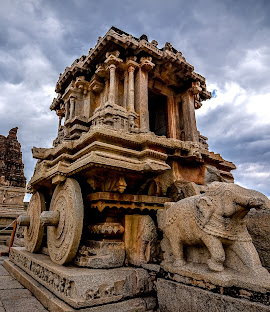
The image shows the Achyutaraya Temple, also known as Tiruvengalanatha Temple, located in Hampi, Karnataka. Constructed in 1534 AD during the reign of King Achyuta Deva Raya of the Vijayanagara Empire, it stands as one of the last grand temples built in the Vijayanagara style. The temple is dedicated to Lord Tiruvengalanatha, a form of Lord Vishnu. Hampi was once a major trading center and the capital of the Vijayanagara Empire, which flourished between the 14th and 16th centuries.
The empire reached its peak under King Krishna Deva Raya (1509-1529), and the Achyutaraya Temple was built during the reign of his successor, Achyuta Deva Raya (1529-1542).
After the decline of the Vijayanagara Empire due to attacks, the temple fell into ruin and disrepair. The temple complex includes a garbhagriha (sanctum) which once housed an idol of Lord Tiruvengalanatha, a hundred-pillared hall, and an open hall with intricately carved pillars.

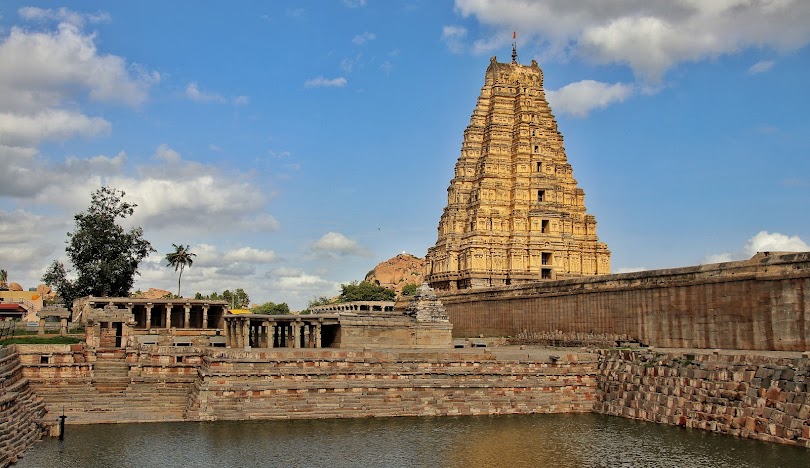
The Virupaksha Temple in Hampi is a historically significant Hindu temple dedicated to Lord Shiva in his Virupaksha form, dating back to the 7th century. It evolved from a modest shrine into a grand complex during the Vijayanagara Empire, with the temple continuing to function even after the empire’s decline.

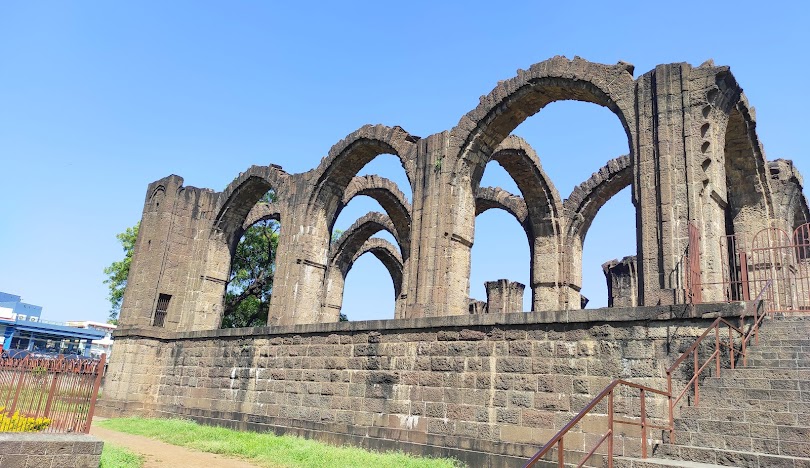
Bara Kaman, located in Vijayapura, Karnataka, is an unfinished mausoleum that dates back to 1672 AD. The structure was commissioned by Ali Adil Shah II of the Adil Shahi dynasty, intended to be his final resting place along with his wives. The original plan included twelve arches placed both vertically and horizontally, surrounding the tomb. However, the mausoleum was left incomplete due to unknown reasons, with only two arches being raised vertically. Some rumors suggest that the construction was halted because, upon completion, its shadow would overshadow the Gol Gumbaz.
The structure, designed by Malik Sandal, an Abyssinian eunuch, is a large square building with incomplete arches made of dark basalt. The platform on which the arches stand is 20 feet high and 215 feet square, larger than the Gol Gumbaz’s platform, which is 158 feet square. It houses the tombs of Ali Adil Shah II, his wife Chand Bibi, and other family members. The site is currently maintained by the Archaeological Survey of India.
